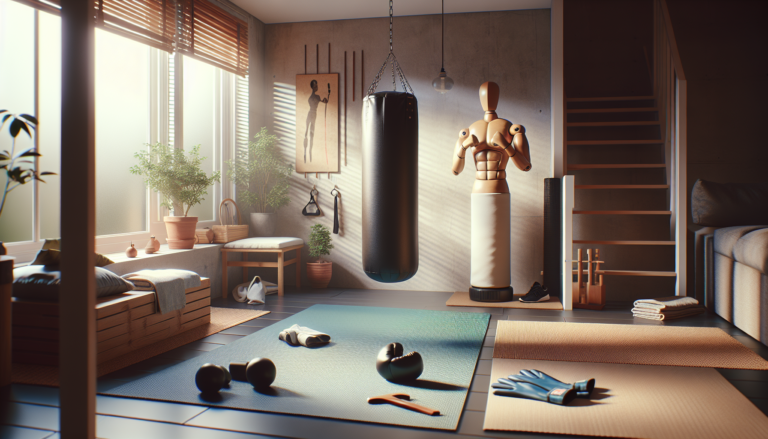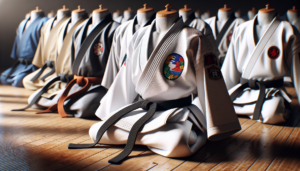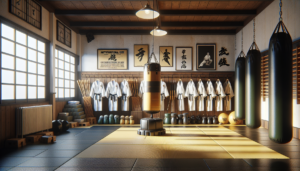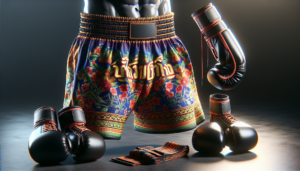Introduction to Martial Arts at Home
Martial arts have long been a popular form of self-defense, fitness, and discipline. While traditional training takes place in a dojo or gym under the guidance of an instructor, it is possible to practice martial arts at home. Home martial arts training offers the convenience and flexibility to learn and refine techniques on your own schedule. However, it is important to approach home training with caution and proper preparation.
Before diving into martial arts training at home, it is crucial to have a solid foundation in the basics. This may involve attending classes at a local martial arts school or studying under an experienced instructor to learn proper form, technique, and safety protocols. Without guidance from a qualified teacher, beginners risk developing poor habits or even injuring themselves. Once you have a grasp of the fundamentals, you can supplement your learning with home practice.
Benefits of Training Martial Arts at Home
One of the main advantages of martial arts at home is the ability to train on your own time. You can fit in sessions around your work schedule, family obligations, and other commitments. Home training also eliminates the need to commute to a gym or dojo, saving time and money on membership fees and equipment costs.
Practicing martial arts at home allows you to move at your own pace. You can spend extra time perfecting techniques that challenge you or breeze through exercises you have already mastered. Home martial arts training is also a great way to introduce family members, including children, to the benefits of martial arts in a comfortable setting.
Challenges of Training Without an Instructor
Learning martial arts at home comes with its own set of challenges, the most significant being the lack of a trained instructor to provide guidance and correction. Without an experienced eye to spot errors in form or technique, you may inadvertently reinforce bad habits that hinder your progress and increase your risk of injury.
Training solo also means you miss out on partner drills that teach timing, distance control, and reaction skills. Sparring is a key component of martial arts that is difficult to replicate alone. Additionally, the motivation and accountability provided by an instructor and classmates can be harder to maintain when training independently.
Essential Equipment for Home Martial Arts Training
While it is possible to practice martial arts with minimal gear, investing in a few key pieces of equipment can greatly enhance your home martial arts training. The type of gear you need will depend on the specific style you study and your training goals.
Setting Up Your Training Space
Before acquiring any equipment, you will need a dedicated space for training. This may be a corner of your living room, a spare bedroom, a garage, or a backyard patio. Ensure the area is free of tripping hazards and has enough room to move around safely. Mats or interlocking foam tiles can provide cushioning for falls and make standing drills more comfortable.
If space is limited, consider modular or multi-purpose equipment that can be easily stored between sessions. Wall-mounted gear like a heavy bag or pull-up bar can maximize vertical space and keep clutter to a minimum.
Must-Have Equipment for Beginners
A punching bag is one of the most versatile tools for martial arts at home. Free-standing bags can be moved around as needed, while hanging bags offer a more stable target. Hand wraps and bag gloves will protect your knuckles and wrists from impact. Kicking pads and a dummy are useful aids for practicing kicking techniques without a partner.
| Equipment | Purpose |
|---|---|
| Punching bag | Practicing striking techniques |
| Wraps & bag gloves | Protecting hands while striking |
| Kicking pads | Practicing kicks solo or with a partner |
| Training dummy | Drilling grappling, footwork and trapping |
Resistance bands can be used for strength training and stretching. A jump rope is a great addition for warm-ups and cardio conditioning. As you progress, you may want to add weapons like foam training knives or a wooden staff.
Basic Techniques to Practice at Home
The martial arts techniques you practice at home will vary depending on your style, but most disciplines incorporate elements of striking, kicking, footwork, and body conditioning. Beginners should focus on perfecting their form and committing basic movements to muscle memory.
Shadow Boxing for Technique and Conditioning
Shadow boxing is a staple exercise for home martial arts training. It involves practicing techniques against an imaginary opponent, which allows you to perfect your form and flow without the need for a partner or equipment. Choose a few fundamental strikes or combinations to drill repeatedly. Pay close attention to your posture, balance, and breathing.
Shadow boxing is also a great cardio workout. Maintain a steady rhythm and gradually increase your speed and intensity. Incorporate slips, bobs, and weaves to simulate defensive movement. Visualize your opponent’s attacks and practice your counters and evasions.
Practicing Punches and Kicks
Punches and kicks form the backbone of most martial arts techniques. Beginners should start with basic punches like jabs, crosses, hooks, and uppercuts. Practice each strike slowly at first, focusing on proper alignment and power generation from the hips and core. As you become more comfortable, increase your speed and combine punches into simple combinations.
Kicking techniques vary widely between styles but often include front kicks, side kicks, roundhouses, and back kicks. As with punches, start slowly and emphasize proper form over power or velocity. Use a kicking pad or heavy bag to provide feedback and resistance as your accuracy improves.
- Jab: A quick, straight punch delivered with the lead hand
- Cross: A powerful straight punch thrown from the rear hand
- Hook: A close-range punch with a bent elbow, striking laterally
- Uppercut: A vertical punch traveling upward from a crouched stance
- Front Kick: A linear kick using the ball of the foot
- Side Kick: A kick delivered perpendicular to the target with the blade of the foot
- Roundhouse Kick: A circular kick striking with the shin or instep
- Back Kick: A powerful kick delivered to the rear while facing away from the target
Conditioning and Fitness for Martial Arts
Physical conditioning is an essential component of home martial arts training. Strength, endurance, flexibility, and explosive power are all attributes that will enhance your performance and help prevent injuries. Many exercises can be performed with little or no equipment.
Basic Conditioning Exercises
Bodyweight exercises like push-ups, pull-ups, squats, and lunges build functional strength that directly translates to martial arts techniques. Core training, including crunches, planks, and leg lifts, is crucial for maintaining stability and balance during dynamic movements.
High-intensity interval training (HIIT) is an effective way to boost your aerobic and anaerobic endurance. Alternate short bursts of intense exercise, like sprints or burpees, with periods of active rest. Jump rope drills are another excellent option for conditioning the lower body and developing coordination.
Incorporating Fitness Boxing
Fitness boxing routines can complement your martial arts training at home by improving cardiovascular health, agility, and power. Shadowboxing, hitting the heavy bag, and performing footwork drills are all elements of a well-rounded fitness boxing regimen.
Look for guided workouts online or invest in a virtual coaching app to provide structure and motivation. Many programs offer a mix of boxing-inspired exercises and general conditioning moves like jumping jacks or mountain climbers. As your fitness improves, challenge yourself by increasing the length or intensity of your workouts.
Advanced Training Techniques
As you progress in your martial arts at home training, you may want to incorporate more sophisticated tools and methods into your practice. These techniques can help refine your skills and simulate more realistic combat scenarios.
Using a Double End Bag
A double end bag is a small, air-filled ball attached to the floor and ceiling with elastic cords. Unlike a heavy bag, a double end bag swings erratically when struck, mimicking the unpredictable motion of a live opponent. Training with a double end bag improves hand-eye coordination, rhythm, and reaction time.
Begin by practicing basic punches and maintaining a steady rhythm as the bag rebounds. As your timing improves, start adding slips, ducks, and counter punches in response to the bag’s movement. More advanced drills can include punch combinations, lateral footwork, and head movement.
Sparring at Home
Sparring at home can be challenging without a partner, but there are ways to simulate the experience. Investing in a grappling dummy or body opponent bag provides a three-dimensional target for practicing throws, clinches, and ground fighting techniques. Interactive training programs that use motion sensors or video feedback can help refine your sparring skills by tracking your speed, accuracy, and reaction times.
When sparring with a partner at home, always prioritize safety. Wear appropriate protective gear like headgear, mouthguards, and sparring gloves. Agree on the intensity level beforehand and use a safe word to pause the action if necessary. If possible, have an experienced practitioner supervise your sparring sessions.
Supplementing Your Training
While it is possible to make significant progress in martial arts at home, seeking outside instruction and feedback is still important for long-term growth and skill development. Here are some ways to supplement your solo training:
Using Instructional Videos
Instructional videos featuring experienced martial arts instructors can provide guidance and inspiration for your home training sessions. Many online platforms offer free or low-cost tutorials covering a wide range of styles and techniques. Look for reputable instructors with proven credentials in their discipline.
When following along with a video, pay close attention to the instructor’s form and movement. Pause, rewind, and rewatch sections as needed to fully grasp the concepts being taught. Keep in mind that video instruction is not a substitute for personalized feedback, but it can be a valuable supplement to your training routine.
Joining Online Communities
Connecting with other martial arts practitioners through online communities can provide support, motivation, and opportunities for growth. Many forums, social media groups, and subreddits are dedicated to martial arts at home training.
These communities can be a great place to ask questions, share progress, and learn from more experienced members. Some groups may organize virtual training sessions or video chats where members can practice together in real-time. Participating in online discussions can also expand your knowledge of martial arts history, culture, and current events.
Conclusion and Encouragement
Training martial arts at home can be a rewarding and enriching experience. With dedication, creativity, and proper safety precautions, it is possible to make significant progress in your physical skills and mental discipline.
Consistency and Gradual Skill Development
The key to success in any martial art is consistent practice. Set realistic goals for your home martial arts training and strive to improve gradually over time. Celebrate your small victories and learn from your challenges. Remember that progress is not always linear, and setbacks are a natural part of the learning process.
Incorporate martial arts training into your daily routine, even if it’s just for a few minutes. Regular practice will help ingrain techniques into your muscle memory and improve your overall fitness. As you become more comfortable with the basics, challenge yourself to learn new skills or increase the intensity of your workouts.
Starting Your Martial Arts Journey
If you are new to martial arts, starting your training at home can be a great way to explore different styles and discover what resonates with you. Many schools offer free trials or introductory classes to help you get a feel for their teaching methods and culture.
Remember that martial arts at home training is just one part of a comprehensive self-defense strategy. In addition to physical skills, consider studying verbal de-escalation techniques, situational awareness, and personal safety best practices.
Above all, approach your martial arts journey with an open mind, a willing spirit, and a commitment to personal growth. With time and practice, you may be surprised at how far your home martial arts training can take you.






